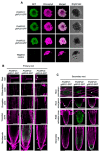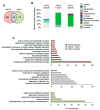A Global Proteomic Approach Sheds New Light on Potential Iron-Sulfur Client Proteins of the Chloroplastic Maturation Factor NFU3
- PMID: 33143294
- PMCID: PMC7672563
- DOI: 10.3390/ijms21218121
A Global Proteomic Approach Sheds New Light on Potential Iron-Sulfur Client Proteins of the Chloroplastic Maturation Factor NFU3
Abstract
Iron-sulfur (Fe-S) proteins play critical functions in plants. Most Fe-S proteins are synthetized in the cytosol as apo-proteins and the subsequent Fe-S cluster incorporation relies on specific protein assembly machineries. They are notably formed by a scaffold complex, which serves for the de novo Fe-S cluster synthesis, and by transfer proteins that insure cluster delivery to apo-targets. However, scarce information is available about the maturation pathways of most plastidial Fe-S proteins and their specificities towards transfer proteins of the associated SUF machinery. To gain more insights into these steps, the expression and protein localization of the NFU1, NFU2, and NFU3 transfer proteins were analyzed in various Arabidopsis thaliana organs and tissues showing quite similar expression patterns. In addition, quantitative proteomic analysis of an nfu3 loss-of-function mutant allowed to propose novel potential client proteins for NFU3 and to show that the protein accumulation profiles and thus metabolic adjustments differ substantially from those established in the nfu2 mutant. By clarifying the respective roles of the three plastidial NFU paralogs, these data allow better delineating the maturation process of plastidial Fe-S proteins.
Keywords: Arabidopsis; NFU1; NFU2; NFU3; chloroplast; iron-sulfur cluster; maturation factor; quantitative proteomic.
Conflict of interest statement
The authors declare no conflict of interest.
Figures







References
-
- Pilon M., Abdel-Ghany S.E., Van Hoewyk D., Ye H., Pilon-Smits E.A. Biogenesis of iron-sulfur cluster proteins in plastids. Genet. Eng. 2006;27:101–117. - PubMed
MeSH terms
Substances
LinkOut - more resources
Full Text Sources
Molecular Biology Databases
Miscellaneous

